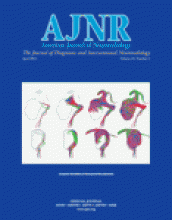Abstract
BACKGROUND AND PURPOSE: T1-weighted spin-echo imaging has been widely used to study anatomic detail and abnormalities of the brain; however, the image contrast of this technique is often poor, especially at low field strengths. We tested a new pulse sequence, T1-weighted fluid-attenuated inversion recovery (FLAIR), which provides good contrast between lesions, surrounding edematous tissue, and normal parenchyma at low field strengths and at acquisition times comparable to those of T1-weighted spin-echo imaging.
METHODS: Thirteen patients with brain lesions underwent T1-weighted spin-echo and T1-weighted FLAIR imaging during the same imaging session. T1-weighted spin-echo and T1-weighted FLAIR images were compared on the basis of four quantitative (lesion-white matter [WM] contrast-to-noise ratio [CNR], lesion-CSF CNR, gray matter-WM CNR, and WM-CSF CNR) and three qualitative criteria (conspicuousness of lesions, image artifacts, and overall image contrast).
RESULTS: CNRs obtained with T1-weighted FLAIR were comparable but statistically superior to those obtained with T1-weighted spin-echo imaging. In general, T1-weighted FLAIR and T1-weighted spin-echo imaging produced comparable image artifacts. Conspicuousness of lesions and the overall image contrast were judged to be superior on T1-weighted FLAIR images.
CONCLUSION: T1-weighted FLAIR imaging may be a valuable alternative to conventional T1-weighted imaging, because the former technique offers superior image contrast at low field strengths and comparable acquisition times.
- Copyright © American Society of Neuroradiology












